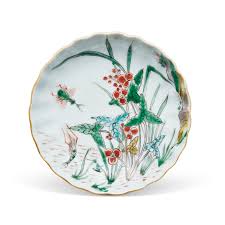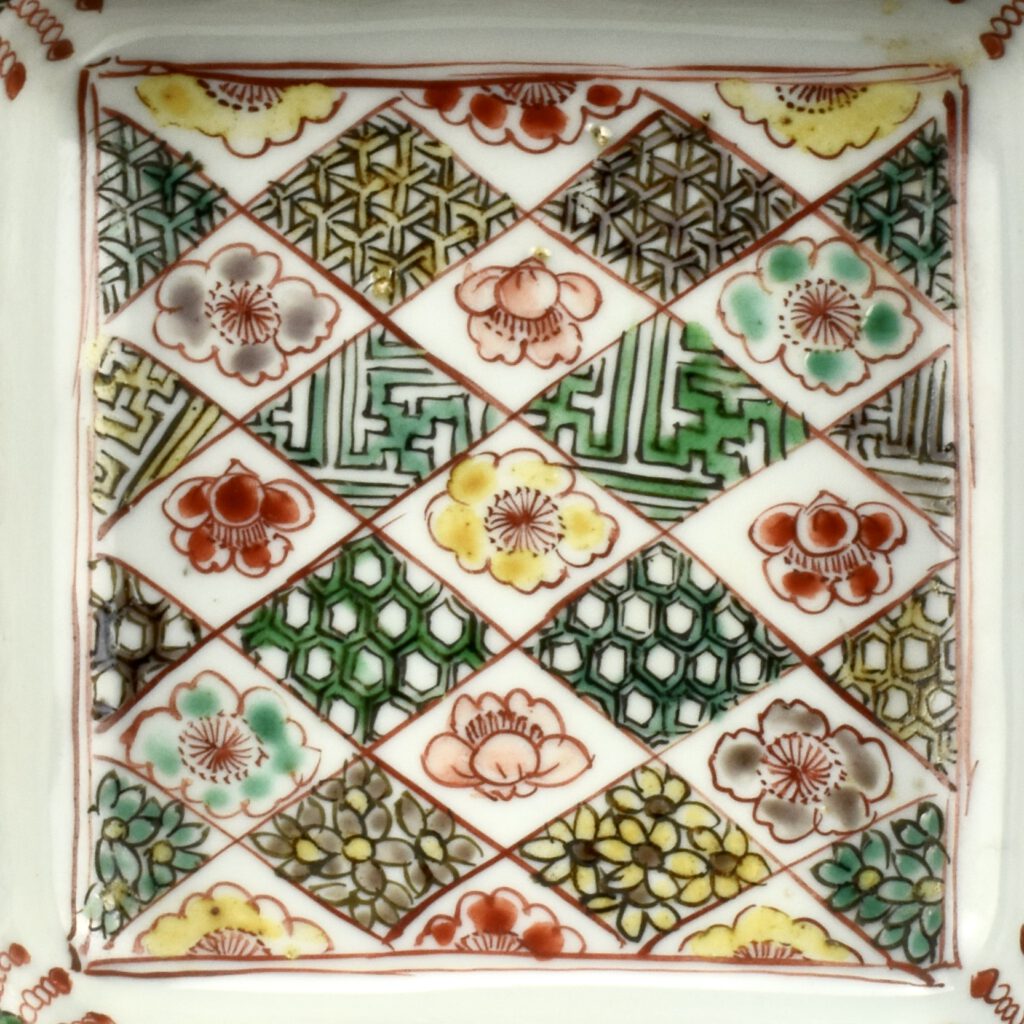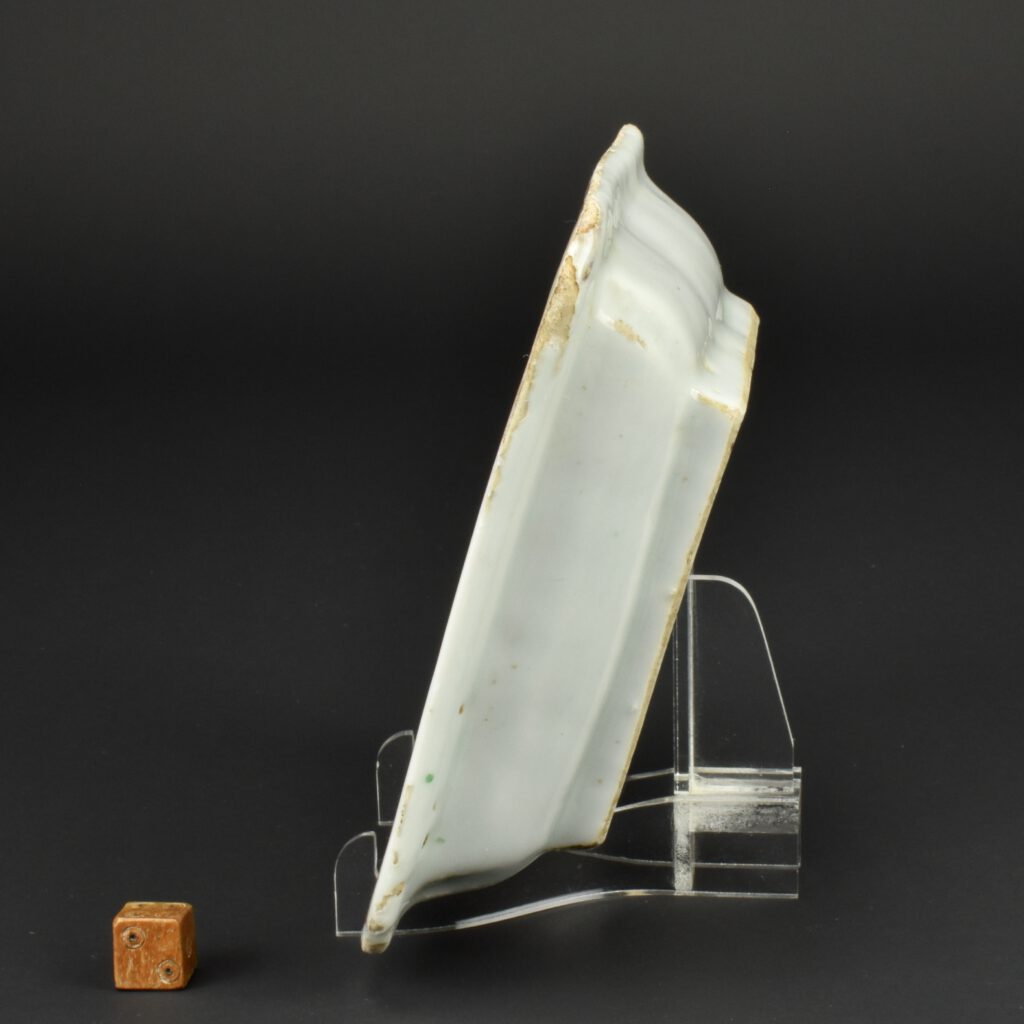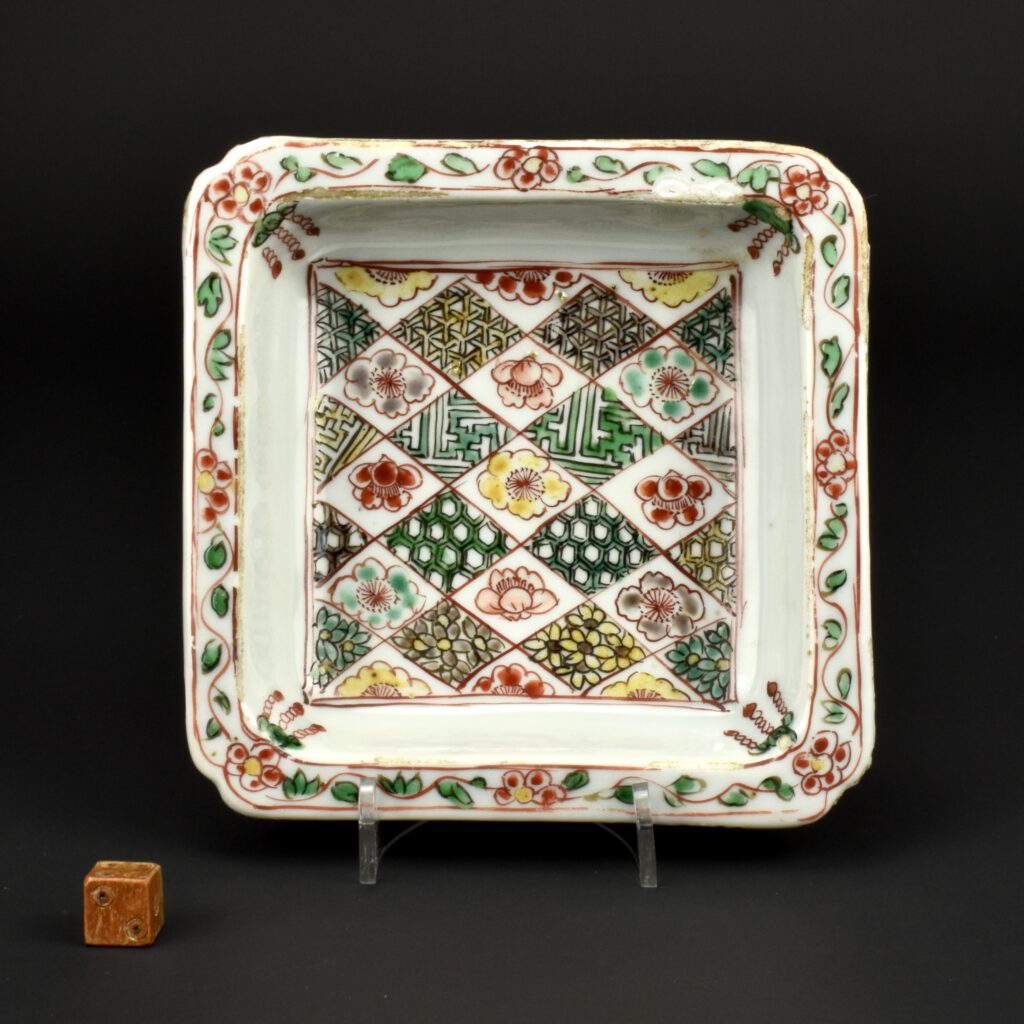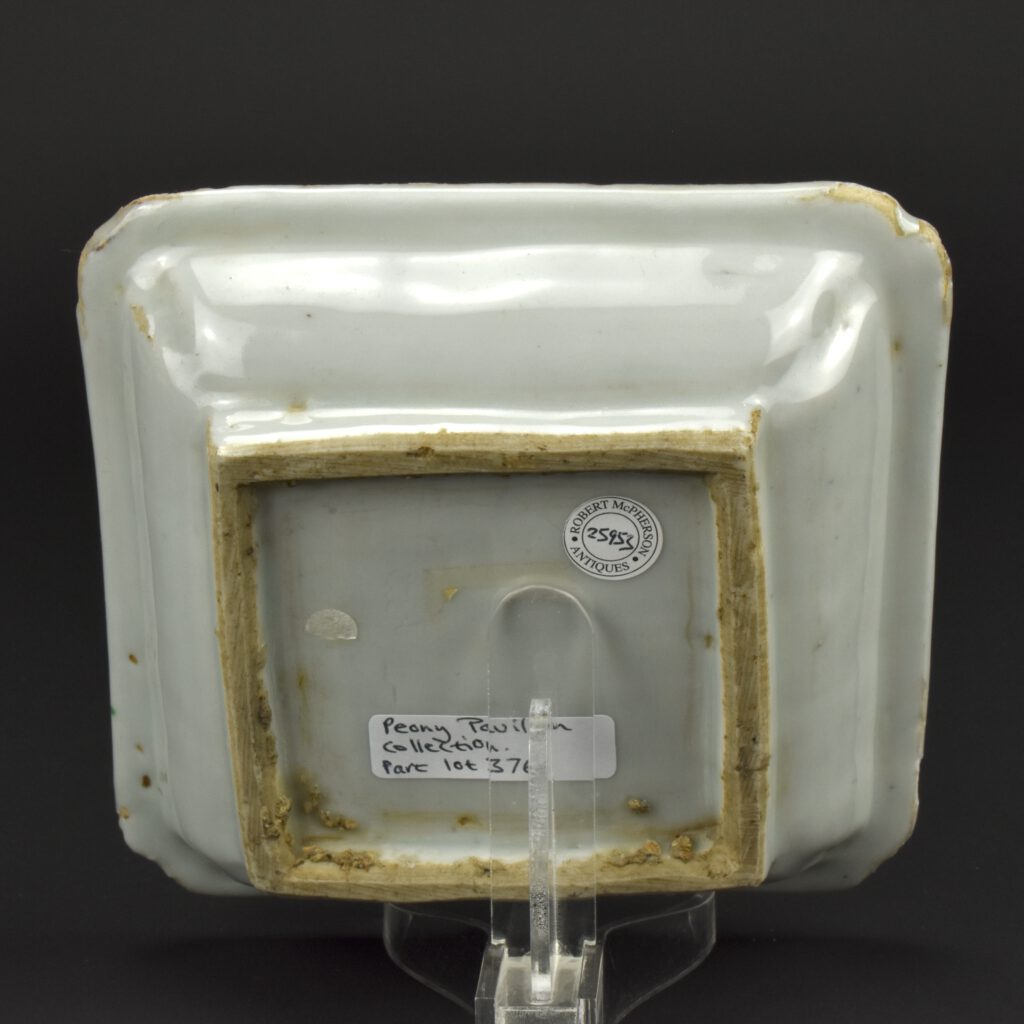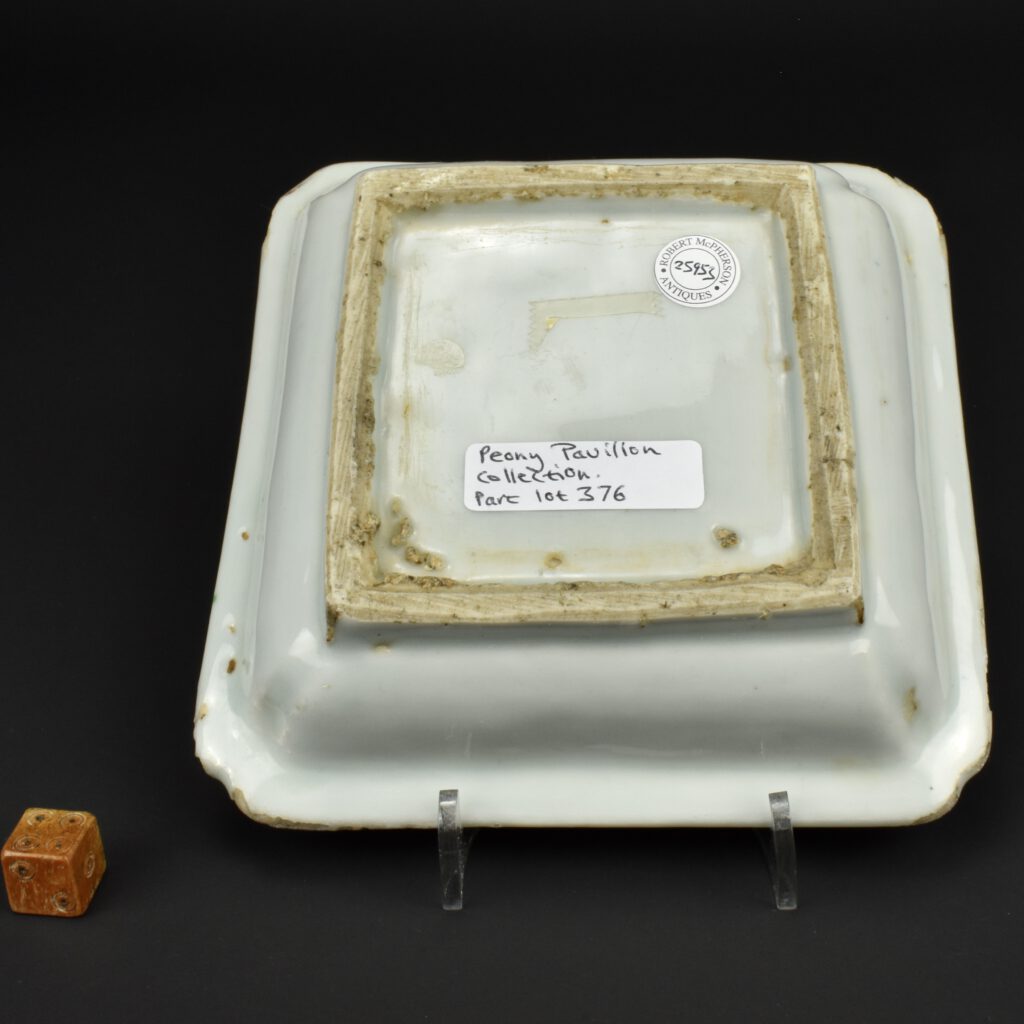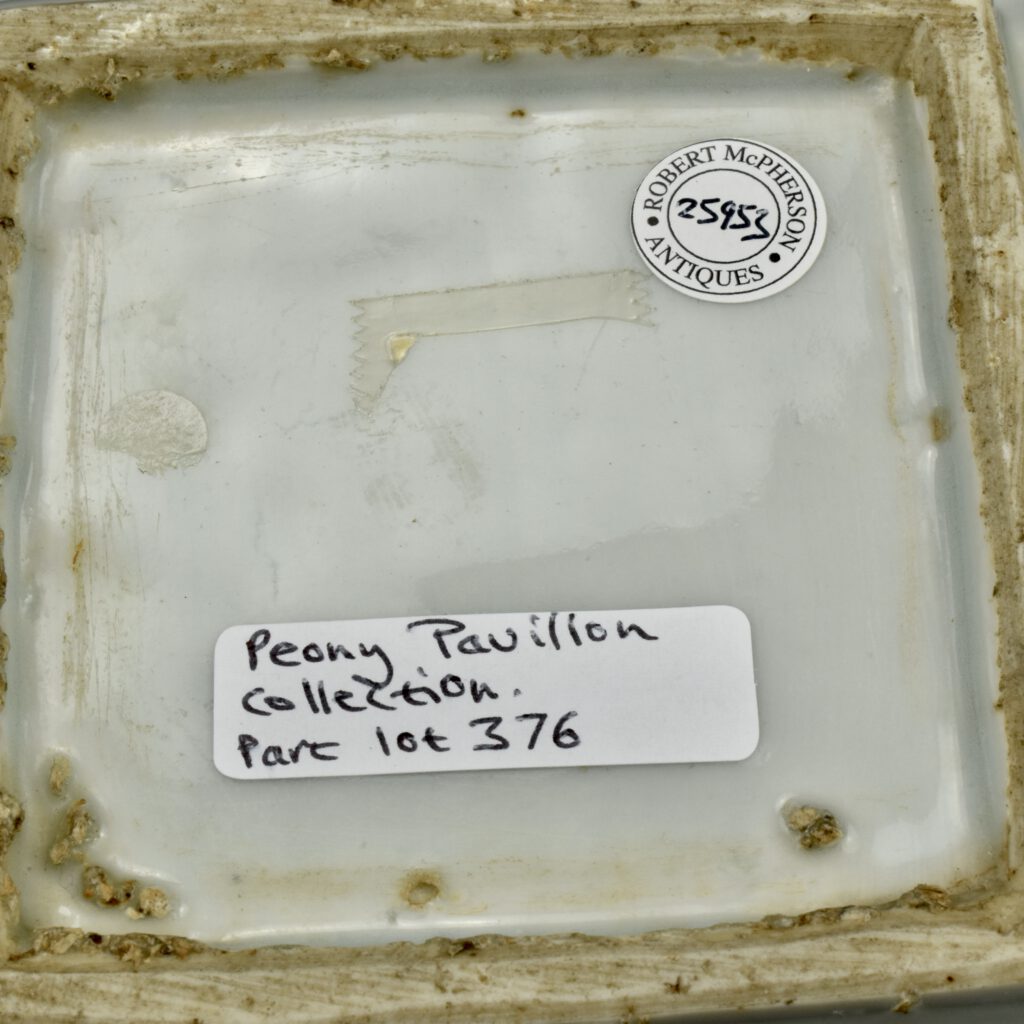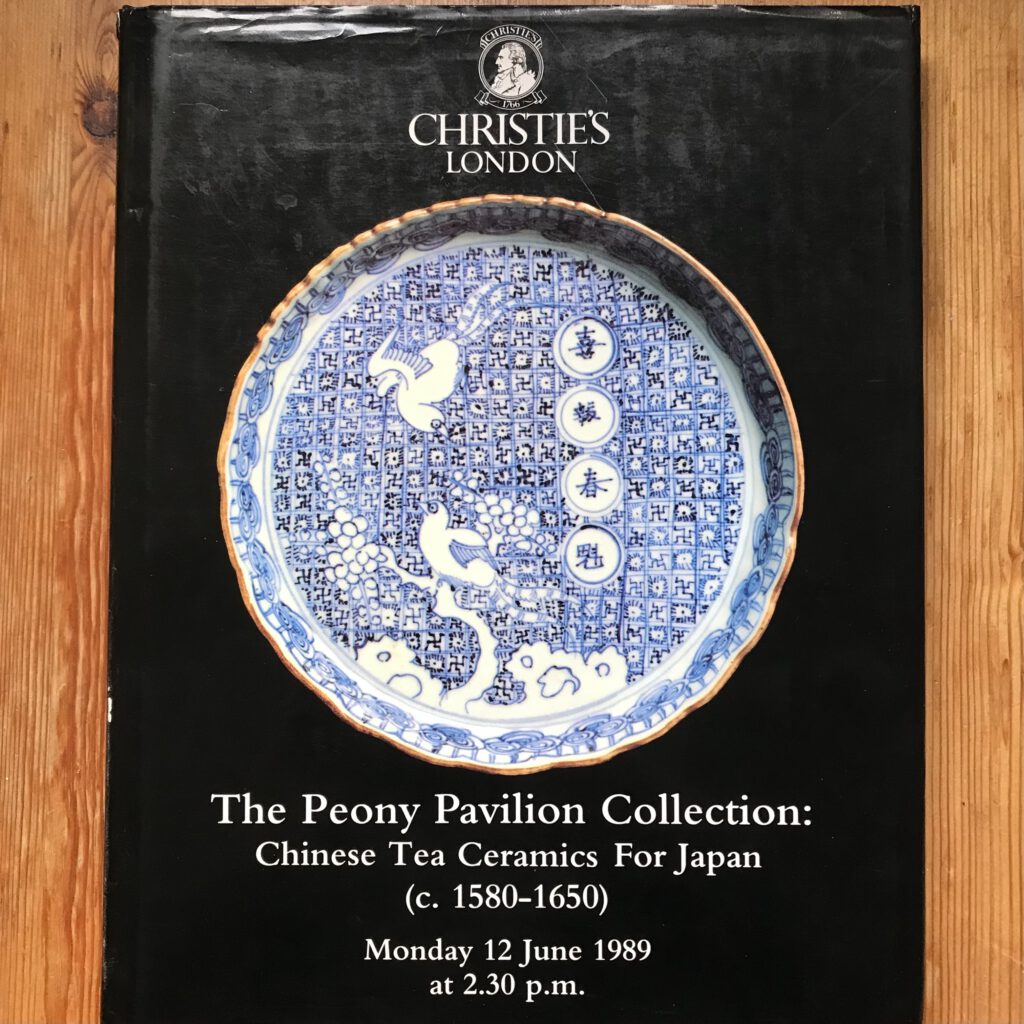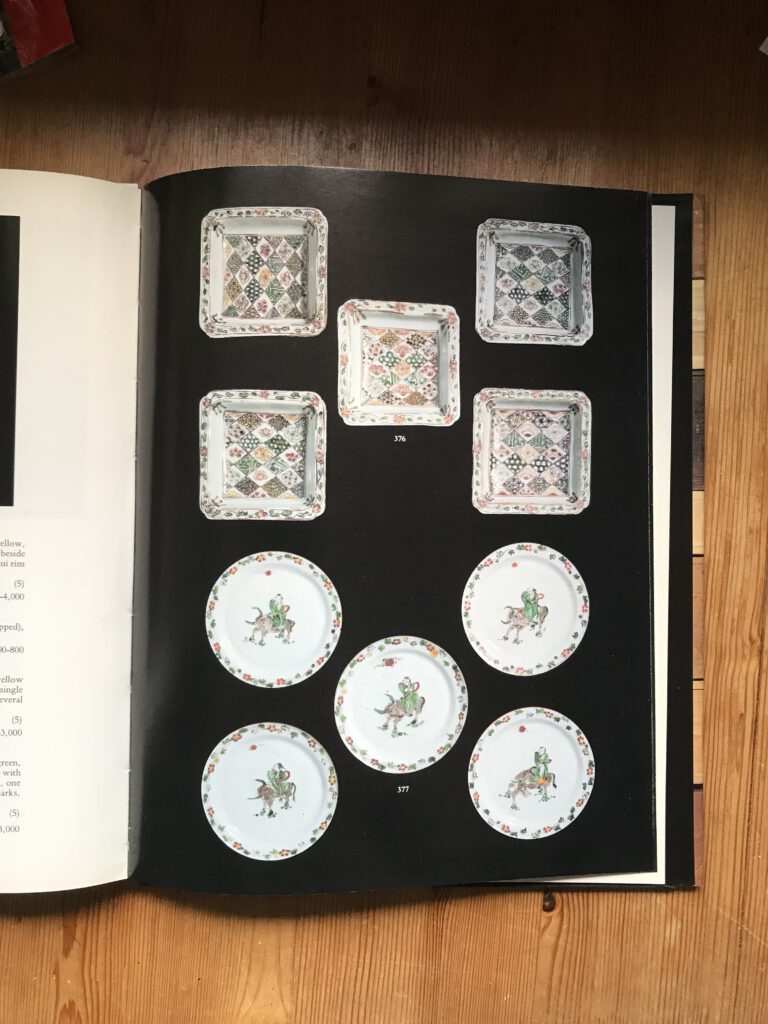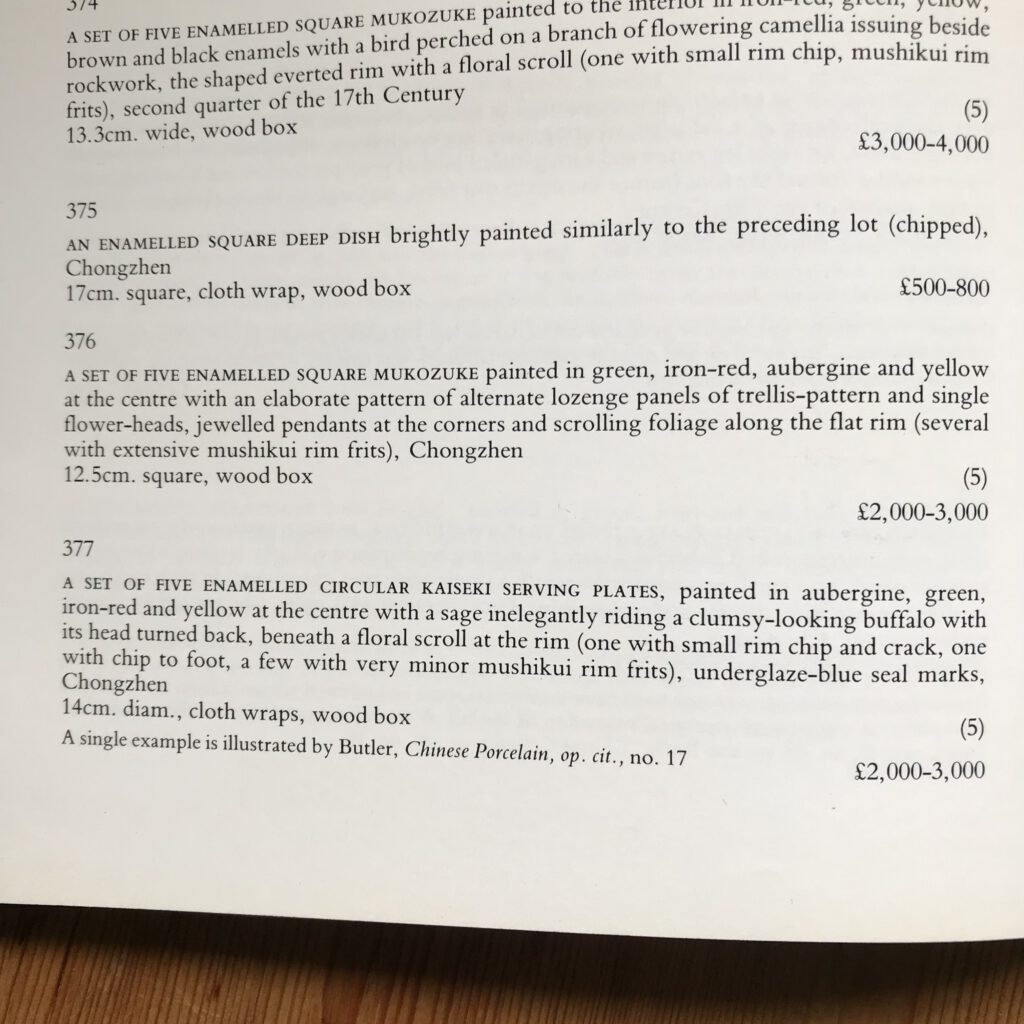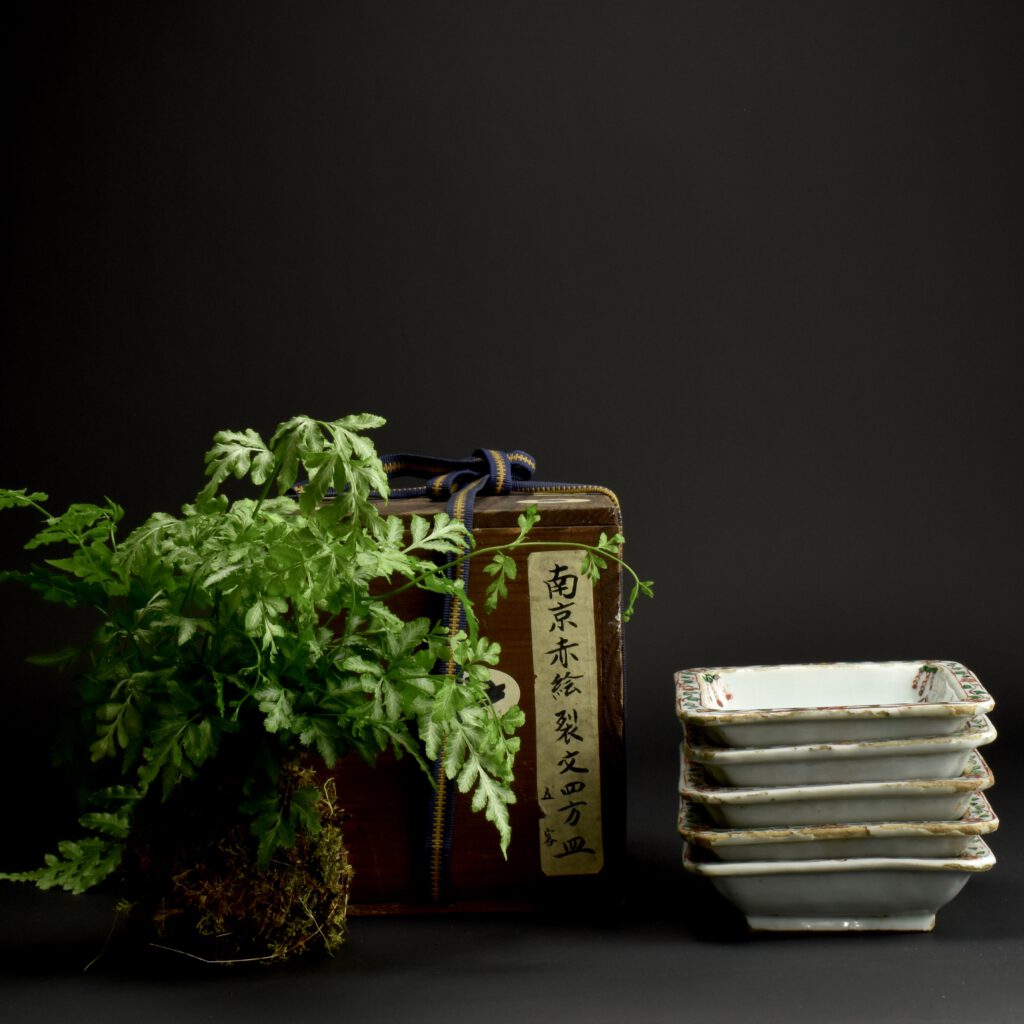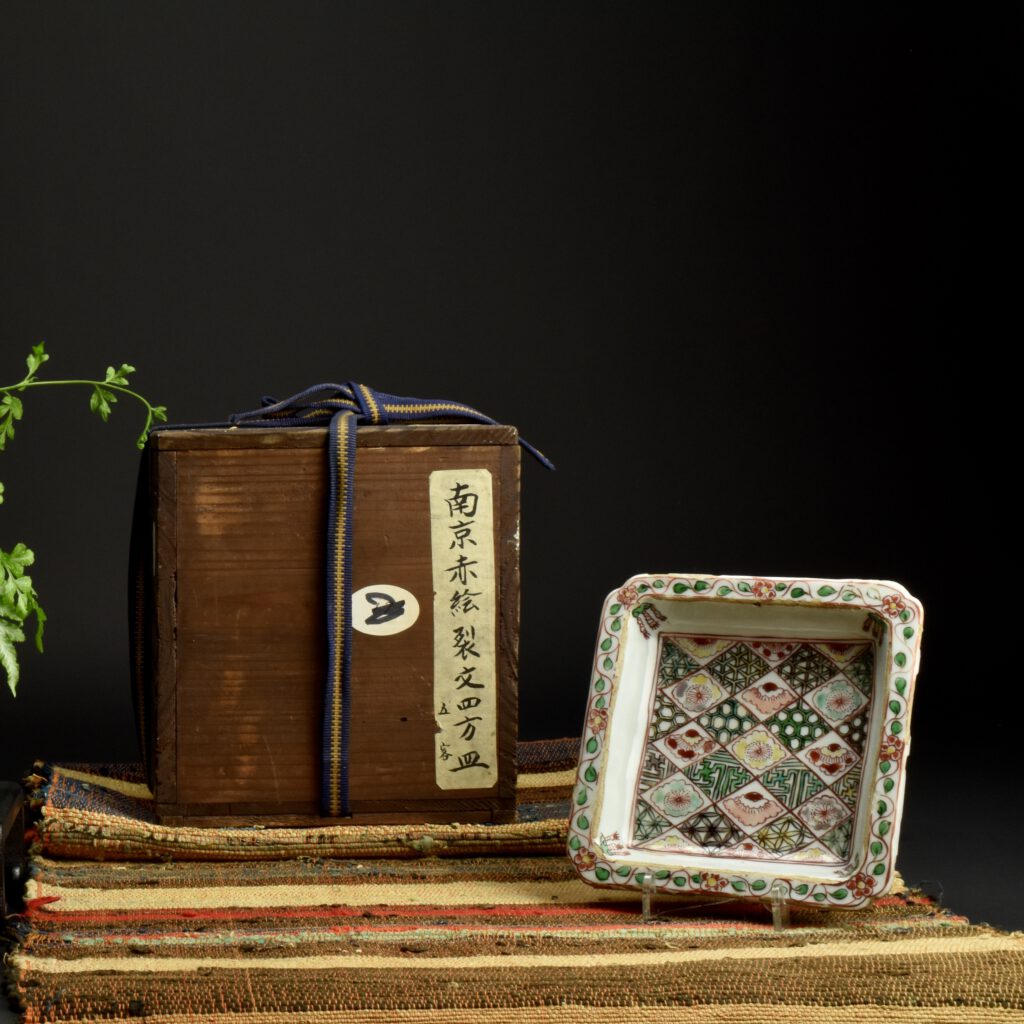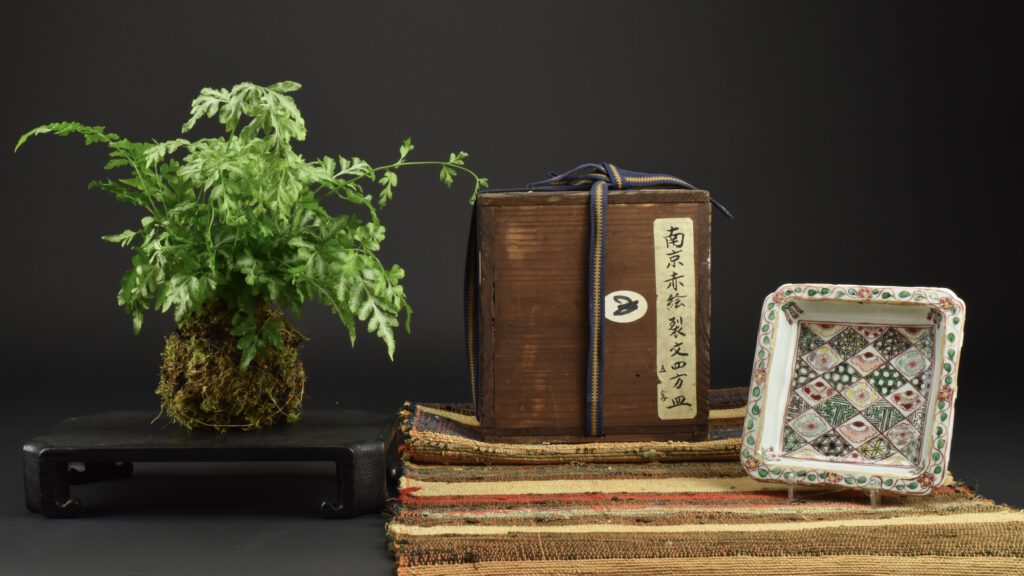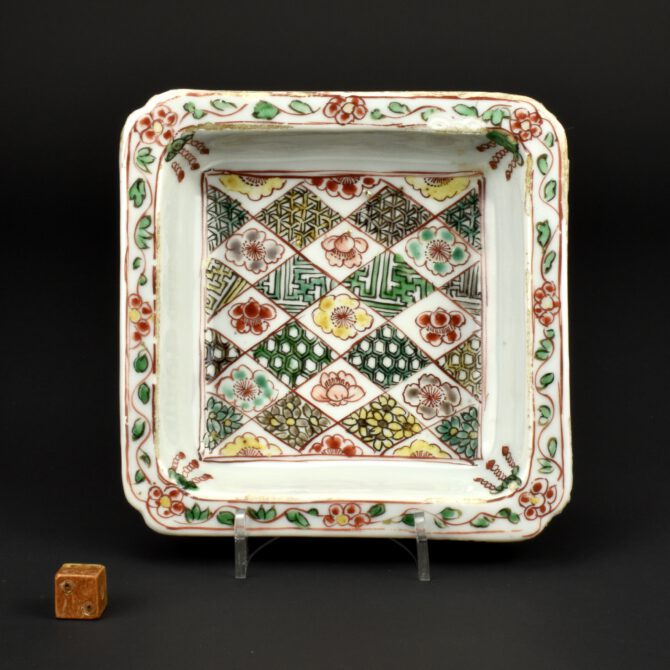
A Rare Ming Porcelain Dish for the Japanese Market from The Peony Pavilion Collection
A Rare Transitional Porcelain Dish Made for the Japanese Market, Jingdezhen Kilns, Ming Dynasty, Chongzhen Period 1628 – 1644. This rare Ming dish Ko-akai Ming porcelain is thickly potted and so is heavy. This serving dish Mukozuke (literally meaning beyond server) was made in for the Kaiseki meal that accompanies the Japanese tea ceremony. Painted in green, iron-red, aubergine (the purple that was so fashionable and rare in Japan) and yellow. This textile inspired design consists of lozenges of trellis with flower-heads, jeweled pendants at the corners and scrolling foliage to the flat rim.
A set of these dishes illustrated in Trade and Transformation, Jingdezhen Porcelain for Japan, 1620-1645 (Julia B.Curtis, China Institute Gallery, New York 2006) page 69, plate 43. Julia Curtis illustrates a set of five of these dishes where she quotes the The Peony Pavilion Collection Catalogue description of lot 359, one of two sets of this rare design in the auction ; “This pattern is known in Japan as the ‘Indian print’ design (Indo-sarasamon). The actual printed cotton textiles were apparently imported to Japan by Chinese merchants trading to Nagasaki, via Canton where they arrived on Arab or Chinese vessels trading to India, during the 17th century and they were regarded as extremely fashionable. They were especially popular with aristocratic ladies based in the Shogun’s palace, and wives of the leading daimyo. The purple colour was in great demand, because Japan had no indigenous material at the time which would produce this rich Indian purple dye (Bengara-iro : possibly a corruption of Bengal)”. A blue and white variant of this design, dated to the Chongzhen period (1628-1644), which gives the impression of two pieces of fabric, one overlaid on the next, is on the front cover of Chinese Ceramics of the Transitional Period 1620-1683 ( Stephen Little, China House Gallery, China Institute in America. 1984) see References.
See below for more photographs and Information.
SOLD
- Condition
- In good condition, glaze chips to the rim, some mushikui (insect nibble, or fritting) that are normally found on this type of porcelain.
- Size
- Diameter 15 cm (5 3/4 inches).
- Provenance
- The Peony Pavilion Collection ; Chinese Tea Ceramics for Japan (c.1580-1650). Christie`s London 12th June 1989, lot 376, set of 5, , page 106. From a Private Collection, this lot was purchased, this piece as well as many others, from the Christie's sale of 1989. I was able to buy the complete group from this private collection.
- Stock number
- 25953
- References
- Published in : The Peony Pavilion Collection ; Chinese Tea Ceramics for Japan (c.1580-1650). Christie`s London 12th June 1989, lot 376, set of 5, page 106. Another set, lot 359, was sold at the same sale (lot 359). A further set set of these dishes are illustrated in : Trade and Transformation, Jingdezhen Porcelain for Japan, 1620-1645 (Julia B.Curtis, China Institute Gallery, New York 2006) page 69, plate 43. A blue and white variant of this design, which gives the impression of two pieces of fabric, one overlaid on the next is on the front cover of Chinese Ceramics of the Transitional Period 1620-1683 ( Stephen Little, China House Gallery, China Institute in America. 1984) front cover and page 74, plate 26.
Information
A Tea Ceremony Cloth from Coromandel Coast, India.
Tea Ceremony Sarasa, India (for the Japanese Market), c. 17th/18th Century.

Ming Porcelain for the Japanese Market from The Peony Pavilion Collection
Robert McPherson Antiques : Sold Archive.
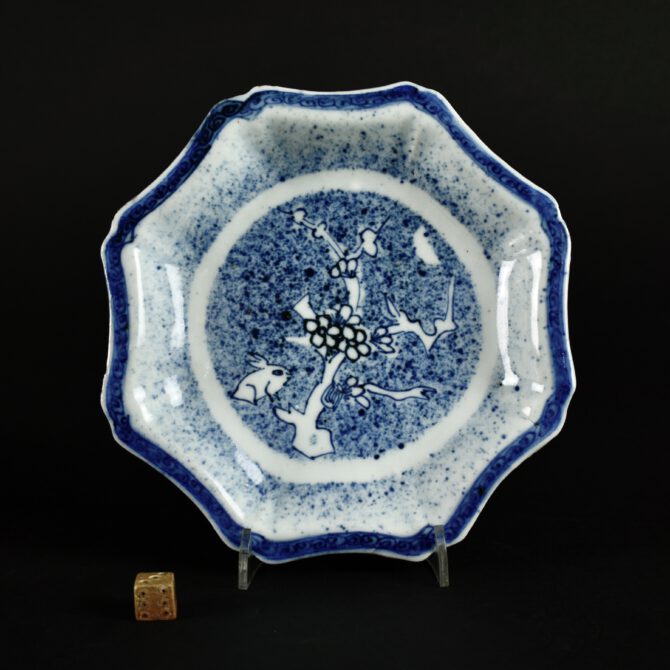
A Rare Ming Spring White Hare Porcelain Dish Made for the Japanese Market. From The Peony Pavilion Collection, Christies 1989, see ‘Provenance’. This late Ming octafoil dish dates from Tianqi or Chongzhen 1621-1644, which is part of the Transitional Period between the Ming and Qing dynasties. The hare, moon, and prunus tree were created with a paper stencil and then covered with Fukizumi (blown ink) and then outlined in cobalt blue after the stencil was removed. In Japan the hare is believed to prepare a food which is the elixir of life. It is possibly that this story, which is adapted from a Chinese, about a hare ponding the elixir of life in a mortar came about because in Chinese ‘full moon and ‘rice cakes’ have the same sound, mochi. With Box.
- Condition
- Minor Mushikui frits.
- Size
- Diameter 16.9 cm (6 3/4 inches)
- Provenance
- The Peony Pavilion Collection ; Chinese Tea Ceramics for Japan (c.1580-1650). Christie`s London 12th June 1989, lot 233, sold for £1,980. From a Private Collection, they purchased this lot as well as others. I was able to buy the complete group.
- Stock number
- 25941
- References
- Published : Ko-sometsuke, two volumes by M. Kawahara (published in 1977), monochrome section, page 161, no.634. Published : The Peony Pavilion Collection ; Chinese Tea Ceramics for Japan (c.1580-1650). Christie`s London 12th June 1989, lot 233.
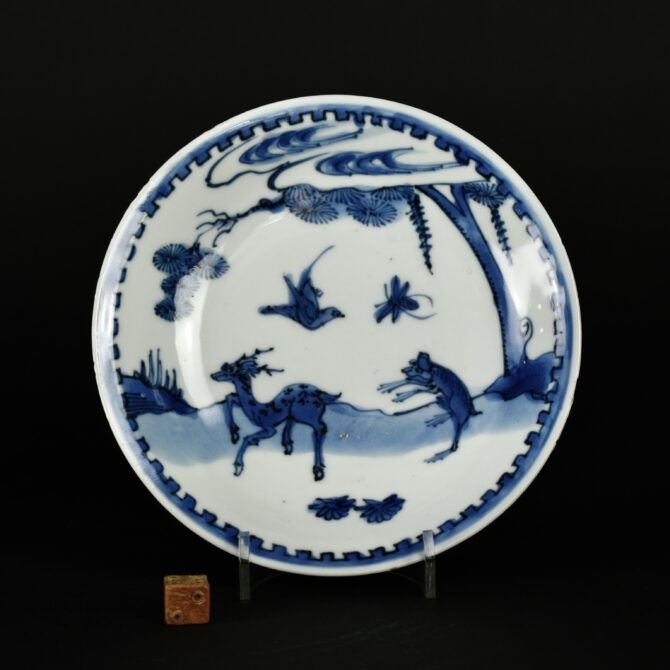
A Late Ming Blue and White Porcelain Dish for the Japanese Market, Tianqi Period 1620 – 1627. This late Ming porcelain dish would have been a Kaiseki, a serving for the Japanese Tea Ceremony meal. The design is of a monkey walking towards a deer, a wasp above with a bird in flight and a pine tree to the right. Parts of this design forms the rebus, juelu fenghou, meaning ‘may you receive high rank and emolument’. The elements taken from the design to create the rebus are ; monkey is hou with a deer lu and wasps feng. The entry for these five Ming dishes in the Peony Pavilion Catalogue has a footnote “A related polychrome example is illustrated in Transitional Wares and Their Forerunners, op. cit., p139″. We sold that dish earlier in the year (2020). See the photograph and reference below the ‘photograph gallery’. The polychrome dish was published and exhibited by the Oriental Ceramics Society of Hong Kong at the Hong Kong Museum of Art in 1981 (see References). There were five of these Ming blue and white Kaiseki dishes sold as lot 294 in the Peony Pavilion Sale in 1989, they came with a box for ten dishes. The other five from the set were sold by Christie’s as lot 295. Box Not Included.
- Condition
- In good condition, very minor mushikui frits
- Size
- Diameter 14.8 cm (5 3/4 inches)
- Provenance
- Published : The Peony Pavilion Collection ; Chinese Tea Ceramics for Japan (c.1580-1650). Christie`s London 12th June 1989, lot 294. Sold £1,650 (set of 5). From a Private Collection, they purchased this piece as well as many others from the Christie's sale of 1989. I was able to buy the complete group from this private collection.
- Stock number
- 25937
- References
- A related polychrome example sold by Robert McPherson Antiques was exhibited in Hong Kong in 1981 see : Transitional Wares and Their Forerunners' (An exhibition presented by the Oriental Ceramics Society of Hong Kong at the Hong Kong Museum of Art in 1981) page 139, colour plate 162.
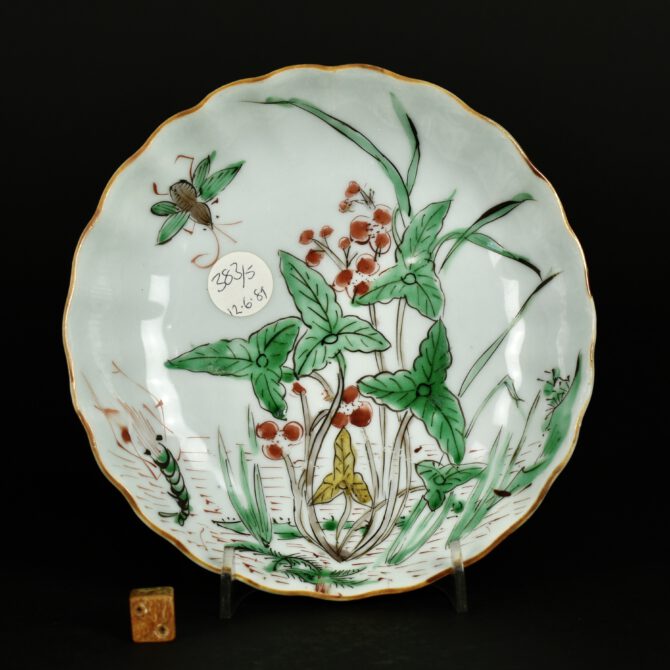
A Ming Porcelain Dish Made for the Japanese Market, Chongzhen Period c.1635-1645. This foliated Transitional Period porcelain dish is painted with bright enamels. The aquatic scene depicts arrowhead Sagittaria sagittifolia as well as other aquatic plants, there is also a leaping shrimp and a flying insect. The design is taken from a woodblock printed book, first published in the Tianqi period 1621-1627, it was a popular book in Japan, where it was known as Hasshu gafu. This Chinese book Bazhong Huapu ‘Manual of Eight Styles of Painting’ was an eight volume collection. This specific design was taken from the illustration of the poem “Arrowroot” in the sixth volume of Bazhong Huapu. The base has an apocryphal six-character Chenghua mark (Ming Dynasty 1465-1487). For more details see below the ‘Photograph Gallery’ below.
Condition
In excellent condition, a small amount of rubbing to a arrowhead leaf due to a small raised area (firing fault).
- Size
- Diameter : 15 cm (6 inches)
- Provenance
- Published : The Peony Pavilion Collection ; Chinese Tea Ceramics for Japan (c.1580-1650). Christie`s London 12th June 1989, lot 383. Sold £1,430 (set of 5). From a Private Collection, they purchased this piece as well as many others from the Christie's sale of 1989. I was able to buy the complete group from this private collection.
- Stock number
- 25964
- References
- Published : The Peony Pavilion Collection ; Chinese Tea Ceramics for Japan (c.1580-1650). Christie`s London 12th June 1989, lot 383. For a Chongzheng dish of this design from Sir Michael Butler, see : Trade Taste and Transformation, Jingdezhen Porcelain for Japan 1620 - 1645 (Julia B. Curtis with contributions from Stephen Little and Mary Ann Rogers. China Institute, China Gallery, New York 2006. ISBN 0-9774054-0-0. 2006). The same dish is also illustrated in : Seventeenth Century Jingdezhen Porcelain from the Shanghai Museum and the Butler Collection (Shanghai Museum,2006. ISBN 1-85759-417-7) page 71 plate 33.
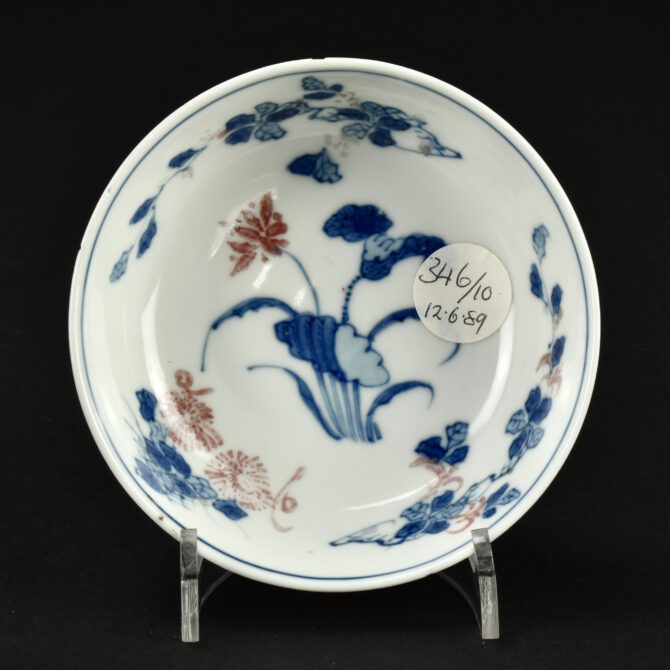
A Rare Copper-Red and Blue Semi-Eggshell Ming Bowl, Wanli Period (1573-1620), Jingdezhen Kilns, Probably Late 16th Century. Apocryphal Xuande six-character mark to base Ming (1423-1435). This finely potted bowl is painted in tones of cobalt blue with strong copper-red pigment. The leading London Dealers, Marchant, in their catalogue “Seventeenth-Century Blue and White and Copper-Red and Their Predecessors” (see references), date the pair they had in 1997 to Wanli c.1590. This is early for Chinese porcelain made for Japan, but the dating does relate to other pieces of especially finely potted Kraak as well as other blue and white porcelain made at the end of the 16th century. The pieces I have seen from this period differ to the early 17th century Chinese porcelain made for Japan in that they lack the firing cracks, roughness, or tears to the body. Those firing faults were deliberate, making the piece and therefore the owner humble, more modest, in the Japanese tradition of Wabi-Sabi. The earlier pieces are quite different. This bowl is of very high quality, it has a fine silky-smooth glaze, the blue tones are carefully placed but most extraordinary of all is the quality of the copper-red. Despite being applied before glazing it is a very temperamental pigment to work with, it can fire with greens or have flecks of green, it can look dull, grey or even disappear completely. This can happen with the most experienced studio potters of our time, yet these ten Ming bowls from the Peony Pavilion Collection have an excellent even copper-red colour. Copper-red was only just being reintroduced at this period, after production stopped in the Mid-15th Century. The design consists of flowering lotus growing out of a pond or lake with sprays of prunus with cherries, flowering lily and chrysanthemum. So many Japanese designs are deeply connected to nature, showing a respect for living things, our interconnectivity with our environment and the small part we play within the natural world. The wood box is not included with this bowl.
Condition
- In very good condition. Three minute glaze frits.
- Size
- Diameter : 9.6 cm (3 3/4 inches).
- Provenance
- The Peony Pavilion Collection ; Chinese Tea Ceramics for Japan (c.1580-1650). Christie`s London 12th June 1989, lot 346, set of 10. From a Private Collection, this lot was purchased, this piece as well as many others, from the Christie's sale of 1989. I was able to buy the complete group from this private collection.
- Stock number
- 25949
- References
- Published : The Peony Pavilion Collection ; Chinese Tea Ceramics for Japan (c.1580-1650). Christie`s London 12th June 1989, lot 346. For pair of very similar bowls, see : Seventeenth-Century Blue and White and Copper-Red and their Predecessors (Exhibition catalogue, S. Marchant & Son June 1997). They were formerly in the collection of Eugene O' Perkins and exhibited at the Phoenix Art Museum, Arizona between 1983-1988 . Another very similar bowl referred to as being from the Kangxi period was sold at Woolley and Wallis Auction, 17th of May 2022, lot 547, sold for £3,900 (Including commission and VAT). "A CHINESE UNDERGLAZED BLUE AND COPPER-RED BOWL KANGXI 1662-1722 The interior decorated with lotus sprays to the centre, encircled by floral branches at different stages of bloom, the underside decorated with two further foliage sprigs, the base with a six character Xuande mark, 11.2cm. Provenance: from an English private collection, London."
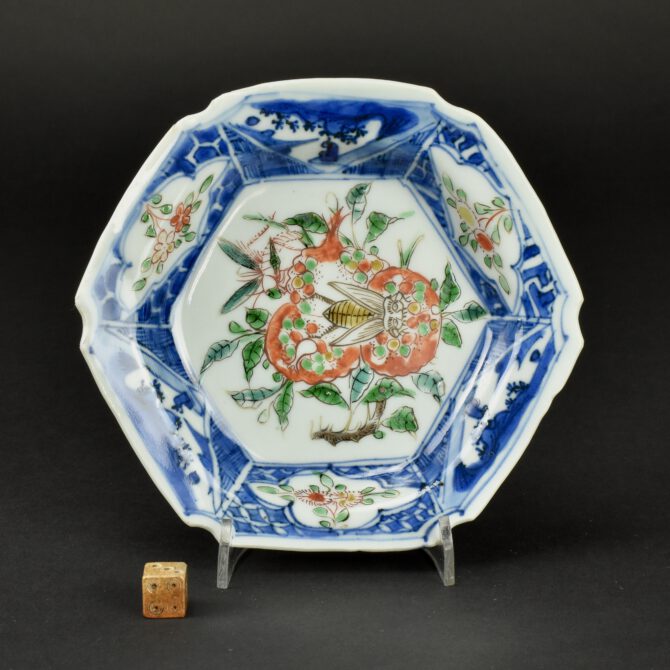
A Transitional Porcelain Dish Made for the Japanese Market, Jingdezhen Kilns, Ming Dynasty, Tianqi 1621 – 1628 or Chongzhen Period 1628 – 1644. This Ming porcelain Mukozuke (literally meaning beyond server) dish was made in for the Kaiseki meal that accompanies the Japanese tea ceremony. The hexagonal shallow form has indented corners with a flat broad rim painted in underglaze blue. This blue underglaze decoration is reminiscent of Kraak porcelain, this is perhaps unsurprising as Kraak ware was popular in 17th century Japan. Indeed, recent research has shown that some kilns in Jingdezhen produced porcelain for the Japanese market also made Kraak ware. The overglaze colours consist of a thickly applied translucent green enamel, a similar but paler green, there is also mustard yellow and aubergine. The red and black decoration is different, it sits flat on the surface of the porcelain, perhaps suggesting little or no glass binder was used. The central decoration depicts a pomegranate branch with three ripe pomegranates bursting open, their seeds of differing colours. A cicada and a grasshopper are feasting on the sweet open fruit. The cavetto has three cartouches decorated with flowering plants in enamel, colours set against a blue diaper patterns of cash (coins, meaning wealth), swastika (conducive to well-being) and a honeycomb design. The other three inverted triangular panels show a solitary seated figure on a promontory with a landscape in underglaze blue. Only one of the dishes from this group of six has an apocryphal Chenghua mark (Ming dynasty 1465-1487).
- Condition
- In very good condition, some mushikui (insect nibble, or fritting) that are normally found on this type of porcelain.
- Size
- Diameter 15 cm (5 3/4 inches).
- Provenance
- The Peony Pavilion Collection ; Chinese Tea Ceramics for Japan (c.1580-1650). Christie`s London 12th June 1989, lot 319, set of 6. From a Private Collection, this lot was purchased, this piece as well as many others, from the Christie's sale of 1989. I was able to buy the complete group from this private collection.
- Stock number
- 25959
- References
- Published in : The Peony Pavilion Collection ; Chinese Tea Ceramics for Japan (c.1580-1650). Christie`s London 12th June 1989, lot 319, set of 6, page 78. For a similar Ming dish dated to the Tianqi period but the center decoration incised see : Leaping The Dragon Gate, The Sir Michael Butler Collection of Seventeenth-Century Chinese Porcelain (Teresa Canepa and Katherine Butler, Ad Ilissvm. ISBN 978-1-912168-16-3. Published 2021). Page 150, plate III 1.204.
Christie's.
Anyone who purchased one of our enamelled dishes from The Peony Pavilion Collection will be pleased to see that a single dish of the same pattern and size made £7,220 in Christie's Hong Kong ;
A RARE ENAMELLED SAUCER DISH
CHONGZHEN PERIOD (1628-1644)
The dish is moulded with fluted petals in the well and is decorated on the interior with a pond depicting a prawn beside flowering arrowheads, with an insect in flight. The base is inscribed with an apocryphal six-character Chenghua mark.
5 7/8 in. (15 cm.) diam.
Provenance : Butler Collection.
Christie's, Hong Kong, 29 Nov 2022
Lot 2941
Sold HKD 69,300 (£7,220).
